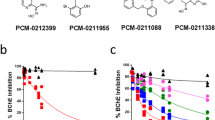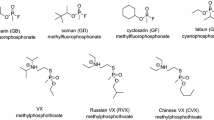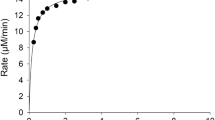Abstract
Methamidophos (O, S-dimethyl phosphorothioamidate) causes polyneuropathy in man and hens. However, experiments in the hen show that lower doses of methamidophos either protect from or promote the neuropathy caused by certain organophosphates. The initiation of neuropathy as well as protection from neuropathy are thought to be related to neuropathy target esterase (NTE), whereas promotion is likely to be due to interactions with another unknown target. Methamidophos is a racemate and we report studies with its resolved optical isomers, aimed at elucidating which isomer is responsible for the described effects. The time-course of acetylcholinesterase (AChE) and NTE activity in nervous tissues of hens after inhibition by single doses of either isomer showed that after d-(+) methamidophos (25 mg/kg PO) peak inhibition of both enzymes was achieved within 24 h (80–90%). However, after l-(-) methamidophos (15 mg/kg PO), peak inhibition (80–90%) was obtained within 24 h for AChE, whereas similar NTE inhibition (120 mg/kg PO) was observed only 4 days after dosing. The minimal neuropathic doses of d-(+) and l-(-) methamidophos were 60 and 120 mg/kg PO, respectively, and correlated with > 80% NTE inhibition in nervous tissues. OPIDP initiation by either isomer was slightly promoted by phenylmethanesulfonyl fluoride (120 mg/kg SC). d-(+) Methamidophos (25 mg/kg PO) partially protected from dibutyl dichlorovinylphosphate (DBDCVP) neuropathy (up to 0.8 mg/kg SC). This effect correlated with about 70% NTE inhibition. l-(-) Methamidophos (15 or 60 mg/kg PO) did not protect from DBDCVP neuropathy (0.2–0.8 mg/kg SC). d-(+) and l-(-) methamidophos (25 mg/kg PO) promoted DBDCVP neuropathy (0.4 mg/kg SC), and d-(+) methamidophos (24 mg/kg PO) also promoted DFP neuropathy (0.3 mg/kg SC). These effects were unrelated to the degree of NTE inhibition they caused: about 70% by d-(+) methamidophos and extrapolated to about 10–15% by l-(-) methamidophos. We conclude that when racemic methamidophos is given to hens, initiation and protection from OPIDP is due to the interaction of d-(+) methamidophos with NTE. Promotion of OPIDP is due to both isomers as the result of their interaction with unknown site(s). It is possible that the neuropathy due to racemic methamidophos or isomers is a self promoted neuropathy because the promoting doses of both isomers are much lower than the neuropathic ones, and because the neuropathy they initiate is only slightly promoted by phenylmethanesulfonyl fluoride.
Similar content being viewed by others
References
Bertolazzi M, Caroldi S, Moretto A, Lotti M (1991) Interaction of methamidophos with hen and human acetylcholinesterase and neuropathy target esterase. Arch Toxicol 65: 580–585
Ellman GL, Courtney KK, Andres W Jr, Featherstone RM (1961) A new and rapid colorimetric determination of acetylcholine-sterase activity. Biochem Pharmacol 7: 88–95
Johnson MK (1970) Organophosphorus and other inhibitors of brain “neurotoxic esterase” and the development of delayed neurotoxicity in hens. Biochem J 120: 523–531
Johnson MK (1974) The primary biochemical lesion leading to the delayed neurotoxic effects of some organophosphorus esters. J Neurochem 23: 785–789
Johnson MK (1977) Improved assay of neurotoxic esterase for screening organophosphates for delayed neurotoxicity potential. Arch Toxicol 37: 113–115
Johnson MK (1990) Organophosphates and delayed neuropathy — is NTE alive and well? Toxicol Appl Pharmacol 102: 385–399
Johnson MK, Read DJ (1987) The influence of chirality on the delayed neuropathic potential of some organophosphorus esters: neuropathic and protective effects of stereoisomeric esters of ethyl phenylphosphonic acid (EPN oxon and EPN) correlate with quantities of aged and unaged neuropathy target esterase in vivo. Toxicol Appl Pharmacol 90: 103–115
Johnson MK, Read DJ (1993) Prophylaxis against and promotion of organophosphate-induced delayed neuropathy by phenyl di-n-pentylphosphinate. Chem-Biol Interact 87: 449–455
Johnson MK, Vilanova E, Read DJ (1991) Anomalous biochemical responses in tests of the delayed neuropathic potential of methamidophos (O, S-dimethyl phosphothioamidate) its resolved isomers and of some higher O-alkyl homologues. Arch Toxicol 65: 618–624
Lotti M (1992) The pathogenesis of organophosphate induced delayed polyneuropathy. Crit Rev Toxicol 21: 465–487
Lotti M, Moretto A, Traverso R (1989) Serum “A”-Esterases and organophosphates toxicity in man. In: Reiner E, Aldridge WN, Hoskin FCG (eds) Esterases hydrolysing organophosphorus compounds. Ellis Horwood, Chichester, pp 193–201
Lotti M, Caroldi S, Capodicasa E, Moretto A (1991) Promotion of organophosphate induced delayed polyneuropathy by phenylmethanesulfonyl fluoride. Toxicol Appl Pharmacol 108: 234–241
Lotti M, Moretto A, Capodicasa E, Bertolazzi M, Peraica M, Scapellato ML (1993) Interactions between neuropathy target esterase and its inhibitors and the development of polyneuropathy. Toxicol Appl Pharmacol 122: 165–171
Moretto A, Lotti M, Spencer PS (1989) In vivo and in vitro regional differential sensitivity of neuropathy target esterase to di-n-butyl-2,2 dichlorovinyl phosphate. Arch Toxicol 63: 469–473
Moretto A, Bertolazzi M, Capodicasa E, Peraica M, Richardson RJ, Scapellato ML, Lotti M (1992) Phenylmethanesulfonyl fluoride elicits and intensifies the clinical expression of neuropathic insults. Arch Toxicol 66: 67–72
Moretto A, Bertolazzi M, Lotti M (1994) The phosphorothioic acid O-(2-chloro-2,3,3,-trifluorocyclobutyl)-O-ethyl S-propyl ester promotes organophosphates polyneuropathy without inhibition of neuropathy target esterase. Toxicol Appl Pharmacol 129: 133–137
Pope CN, Padila S (1990) Potentiation of organophosphorus-induced delayed neurotoxicity by phenylmethylsulfonyl fluoride. J Toxicol Environ Health 31: 261–273
Senanayake N, Johnson MK (1982) Acute polyneuropathy after poisoning by a new organophosphate insecticide. N Engl J Med 306: 155–157
Author information
Authors and Affiliations
Rights and permissions
About this article
Cite this article
Lotti, M., Moretto, A., Bertolazzi, M. et al. Organophosphate polyneuropathy and neuropathy target esterase: Studies with methamidophos and its resolved optical isomers. Arch Toxicol 69, 330–336 (1995). https://doi.org/10.1007/s002040050179
Received:
Accepted:
Issue Date:
DOI: https://doi.org/10.1007/s002040050179




